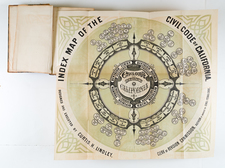Search
Curtis Holbrook Lindley was in 1850 in Marysville, California. His father, Charles Lindley, studied at the Yale Law School, who moved to California in 1849.
Lindley attended Eagleswood Military Academy at Perth Amboy, New Jersey (1865-66) and San Francisco High School (1868-70). He spent the next two years at the University of California.
In 1867, Lindley started out with companions on a prospecting expedition in Nevada. He ran a stationary engine on the Comstock Lode and just before practicing law was stationary engineer at the Union Works.He studied mining engineering as an adjunct to his legal practice of mining law. He was admitted to the California Bar in May 1872 and was almost immediately appointed secretary of the California Code Commission, of which his father was a member.
He practiced law in Stockton, and became the superior judge of Amador County, before moving to San Francisco, forming, in 1890, a partnership with Henry Eickhoff. While on the bench in Amador County, Lindley had occasion to decide several mining cases. He began to specialize in this branch of the law and ultimately published a treatise on the subject (A Treatise on the American Law Relating to Mines and Mineral Lands, 1897).
Prior to WWI, Lindley lectured on mining law at the Leland Stanford, Jr. , University and at the University of California. Among his Stanford students was Herbert Hoover. Upon Hoover's appointment as head of the Food Administration, he called Lindley to Washington as a "dollar-a-year" man to assist in organizing its legal department.
In his final years, he was a law professor at the University of Santa Clara from 1912 to 1920. Lindley is regarded as the pre-eminent mining lawyer and legal scholar related to the general mining laws of the United States. Lindley’s greatest contribution to the legal and mining professions was Lindley on Mines, a treatise on the law of mines first published in 1897.

